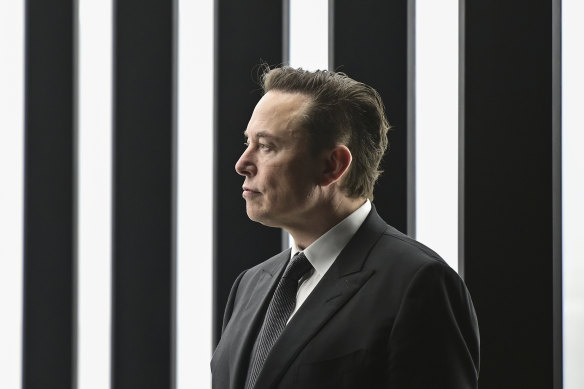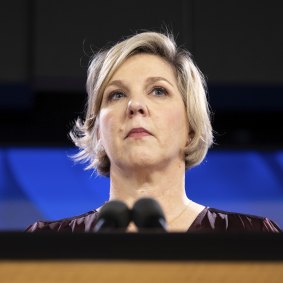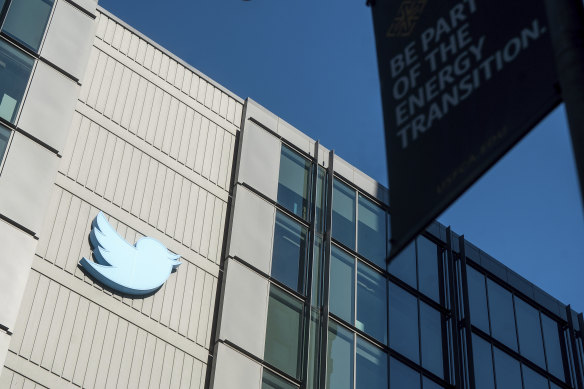This was published 2 years ago
Opinion
Musk needs a fool to help save Twitter and Tesla
Stephen Bartholomeusz
Senior business columnistElon Musk is looking for “someone foolish enough to take the job” to replace him as chief executive of Twitter. Musk’s description of the state of Twitter’s finances suggests that the person would need to be a masochist, or delusional.
Musk put his role as Twitter’s CEO on the line when he asked the platform’s users at the weekend whether he should step down and promised to honour the poll’s outcome. Of the 17.5 million users who voted, more than 10 million, or 57.5 per cent, said he should stand down. He has said he will, once he finds a replacement.
They’re probably not the only ones urging him to relinquish the Twitter role. Shareholders in Tesla, where he is also CEO, are highly agitated after experiencing a 64 per cent – $US772 billion ($A1.2 trillion) – implosion in that company’s value since Musk declared his interest in acquiring Twitter.

Elon Musk in Berlin.Credit: AP
Some shareholders are urging the board, headed by an Australian and former Telstra chief financial officer, Robyn Denholm, to sack him and replace him with a more conventional executive. It’s a board that has previously demonstrated little ability, or inclination, to control its mercurial and eccentric CEO.
Since the completion of his $US44 billion Twitter deal, Musk’s attention has been dominated by his restructuring of the social media platform that he says was on a path to bankruptcy.

Tesla chair Robyn Denholm has defended the lavish pay packet for billionaire Elon Musk.Credit: Alex Ellinghausen
With Tesla struggling to meet its production targets for this year, and cutting prices in China and offering significant financial incentives in the US to generate sales while facing ever-increasing competition from far larger companies in the electric vehicle sector, Tesla can’t afford an absentee CEO.
Musk, however, has about $US24 billion of his own money tied up in Twitter, along with another $US7 billion of equity from third parties and $US13 billion of bank debt.
He has sold about $US23 billion of his Tesla stock this year, including $US3.6 billion last week, and has been trying to entice new investors at the inflated price at which he took Twitter private.
That suggests he wants to replace some of the debt (which the banks haven’t been able to syndicate and are therefore facing substantial paper losses) with equity including, perhaps, more of his own.
His comments at a “Twitter Spaces” event this week disclosed the degree of financial stress in Twitter, some/much of it self-inflicted, and underscore how challenging the task would be for anyone foolish enough to accept the CEO role in the business, a role that would be complicated further by Musk’s status as proprietor and his stated plan to remain in charge of Twitter’s software and engineering.
“No-one wants the job who can actually keep Twitter alive,” he said.
Last year, before Musk, Twitter lost $US220 million on just over $US5 billion of revenue, about 90 per cent ($US4.5 billion) of which was generated from advertising.
This year, Musk said at the Twitter Spaces event, the business was on track to incur $US3 billion of negative cash flows. It was losing $US4 million a day last month. “That is why I spent the last five weeks cutting costs like crazy,” he said. Musk has sacked about 5000 of the 7500 Twitter employees he inherited.
Twitter had been on track to incur costs of about $US5 billion next year, he said, which suggests that it would have been close to break even had it been able to maintain its revenues and Musk hadn’t made his bid.
While adding substantially to Twitter’s debt and its interest costs Musk has also decimated Twitter’s revenues with his commitment to his definition of free speech.
The debt funding element of that bid has added, according to Musk, about $US1.5 billion to the platform’s costs. That implies an average interest rate on the debt of about 12 per cent.
While adding substantially to Twitter’s debt and its interest costs Musk has also decimated Twitter’s revenues with his commitment to his definition of free speech. He got rid of the platform’s small army of content moderators and reopened the platform to users previously banned, including Donald Trump.
Not surprisingly, Twitter experienced an influx of anti-Semitic, racist, sexist and other extreme tweets and, equally unsurprisingly, a significant number of major advertisers withdrew their spends on the platform.
With Musk saying he expected Twitter to generate revenue of about $US3 billion this year, that would imply that more than $US1.5 billion of advertising revenue has evaporated. That loss of revenue and the interest on the acquisition debt accounts for his estimate of $US3 billion of negative cash flows next year had he not slashed costs.
“I now think Twitter will, in fact, be OK next year,” he said, saying that he expected the company to roughly hit cash flow break-even.
To have any chance of achieving even that bare metric of financial stability Musk will have to convince those advertisers who have left the platform, or those that might replace them, that Twitter is a safe place for them to market their products and services.
The alternative would be to find new sources of revenue. The $US8 a month per user revenue from his launched, pulled and relaunched Twitter Blue subscription offer ($US11 a month for IOS users) will be immaterial unless Musk can drive a massive uptake.
With an estimated 140,000 subscribers today (out of nearly 240 million “monetisable users” of the platform) subscription revenues would be only about $US13.5 million. He’d need more than 10 times that number to replace the lost advertising dollars.

The FTC has said that it was following developments at Twitter with “deep concern”.Credit: AP
Longer term, perhaps – and if Twitter can stay afloat in the meantime – Musk’s musing on turning the platform into an “everything” app, like China’s WeChat, which combines social media, messaging, payments and online shopping might offer revenue upside.
If he could use the cash he’s raised from his latest Tesla shares sale, and perhaps find investors foolish enough to invest at the $US54.20 a share price he paid to acquire Twitter, he could reduce the debt burden and its interest costs.
His funds alone would cut Twitter’s borrowings to about $10 billion and the interest costs by roughly $430 million a year to about $1.2 billion a year.
If the banks accepted a haircut – they were being offered only 60 cents in the dollar for the $US6.5 billion leveraged loan component of his funding – he could probably shave another couple of hundred million dollars off the interest bills.
There are, however, a lot of “ifs” that would have to pan out favourably if Musk is to stave off bankruptcy and the loss of the $US23 billion he already has exposed to Twitter’s fate.
The most immediate of them, for Twitter and Tesla’s sake, is finding a fool with the requisite skills (and a thick skin and tiny ego, given Musk’s continuing presence) to develop the content strategies and applications and execute them seamlessly and urgently.
The Business Briefing newsletter delivers major stories, exclusive coverage and expert opinion. Sign up to get it every weekday morning.